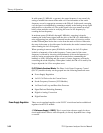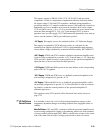
Theory of Operation
2715 Spectrum Analyzer Service Manual
3-25
When the FM coil driver is in use (instrument not phase locked) there are two
potential signal sources summed into the driver circuit. One that is always
present is induced by DAC U850A and subsequent circuits. It is steered into
U821 by switch U757A, and serves to finely set the center frequency. The other
is selected only in moderate spans. It is the sawtooth sweep waveform used to
sweep the 1st LO over spans ranging from 50 kHz/div through 5 MHz/div.
Functionally, this module is a voltage controlled frequency source. It has an
output frequency range from 25.73 MHz through 26.05 MHz in response to a
tuning voltage range of approximately 4 V to 12.5 V. There is also a switch to
select which of two signals is counted by the microprocessor, and there are
means to turn off the output.
The strobe frequency comes from a VCO that ranges from 102.9 MHz through
104.2 MHz and whose output frequency is divided by four to yield the desired
strobe frequency. Its frequency is controlled by phase locking it (with a 100 MHz
offset) to 1/4 the frequency of a free running VCO (the LFVCO) that operates
over a frequency range of 11.68 MHz through 16.84 MHz. It is this LFVCO that
is actually tuned by the incoming tuning voltage referred to earlier, and this
phase locked loop within the VCO module is called the inner loop. The strobe
signal is generated in this manner in order to control close in phase noise and to
provide a countable signal (the LF VCO output) whose frequency is not
condensed into a very narrow range that would require long times to count to
adequate resolution.
The LFVCO consists of Q426, T430, varactors CR532 and CR540, and
associated components. Output (from the collector of Q422) is made available
for external counting through selector switch U240. The LFVCO output
frequency is also divided by four through U410, and the result is the reference
frequency for the inner loop. U512 and U510 serve as a phase/frequency detector
for the inner loop. The differential output of the phase detector is passed through
error amplifier U435 and becomes the tuning voltage for the HFVCO.
The HFVCO consists of Q522, L610, varactor CR511, trim capacitor C611, and
associated parts. Output is taken from a tap on L610, then split through a pair of
isolation amplifiers (Q400 and Q410 plus Q316). Output from Q400 is divided
by four in U300, providing the useful strobe frequency output of the module.
HFVCO output from Q316 is applied to one input of mixer U320, whose other
input is supplied with 100 MHz energy from the Reference Oscillator. The useful
output of the mixer is the difference frequency between the HFVCO (for
example, 103 MHz) and the 100 MHz reference, or 3 MHz. This signal is
amplified (by Q310, Q312, and so forth.) and applied to the remaining input of
the phase/frequency detector, thus closing the inner loop.
U240 serves two functions; both controlled by the logic signals CNTSELA and
CNTSELB. First, it allows turning the HFVCO on or off by means of Q425.
When the oscillator is turned off, Q101 is turned on at the same time to shut
Strobe Frequency
Generator (VCO Module)


















